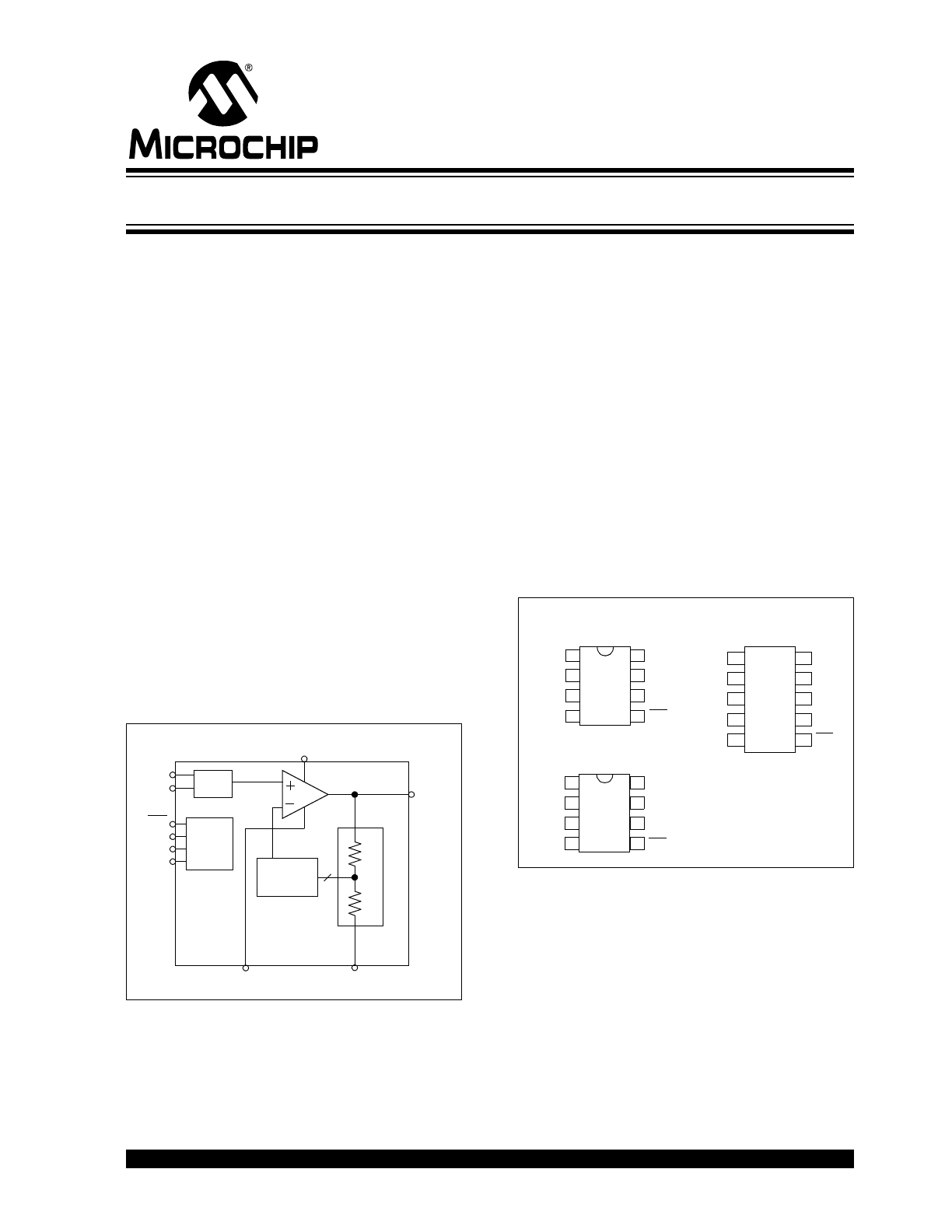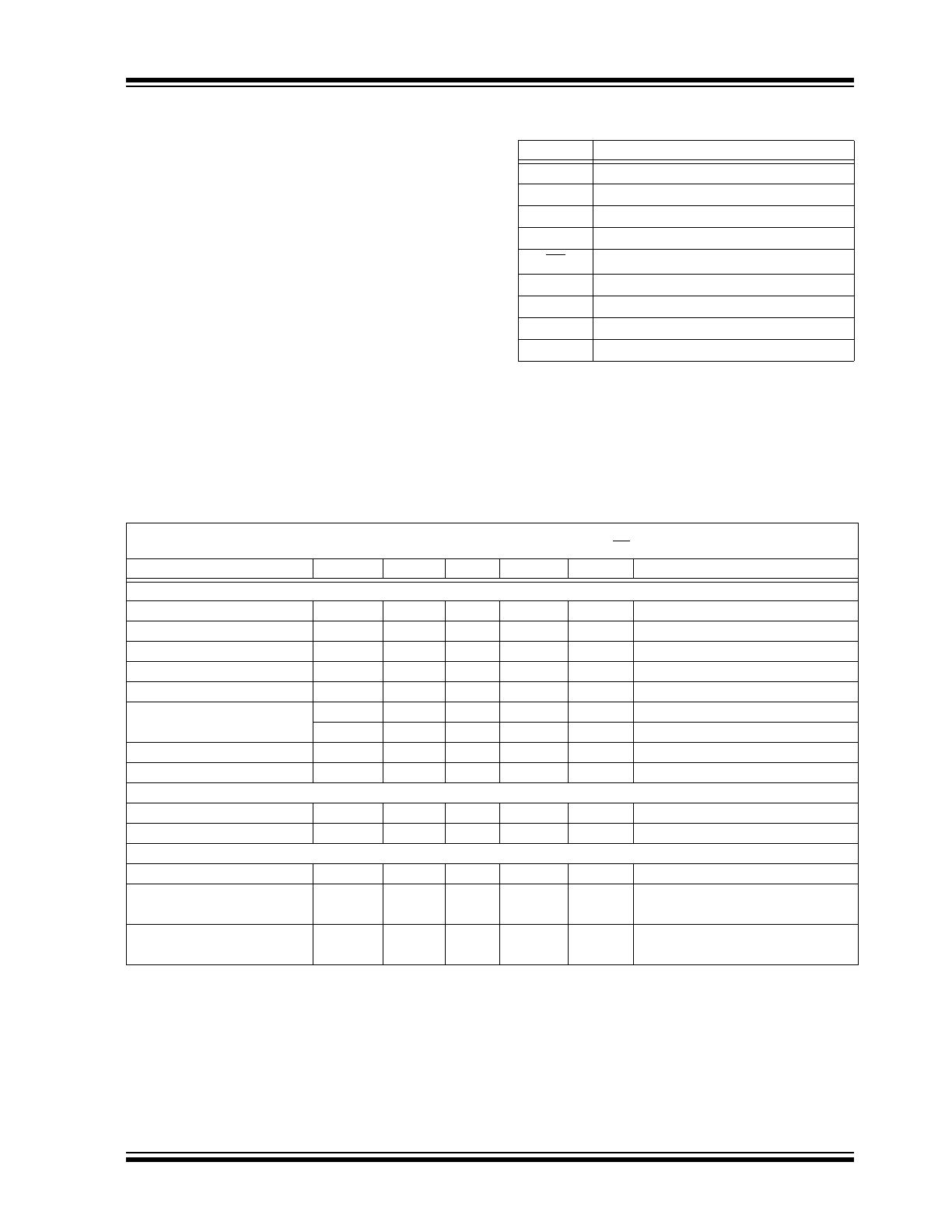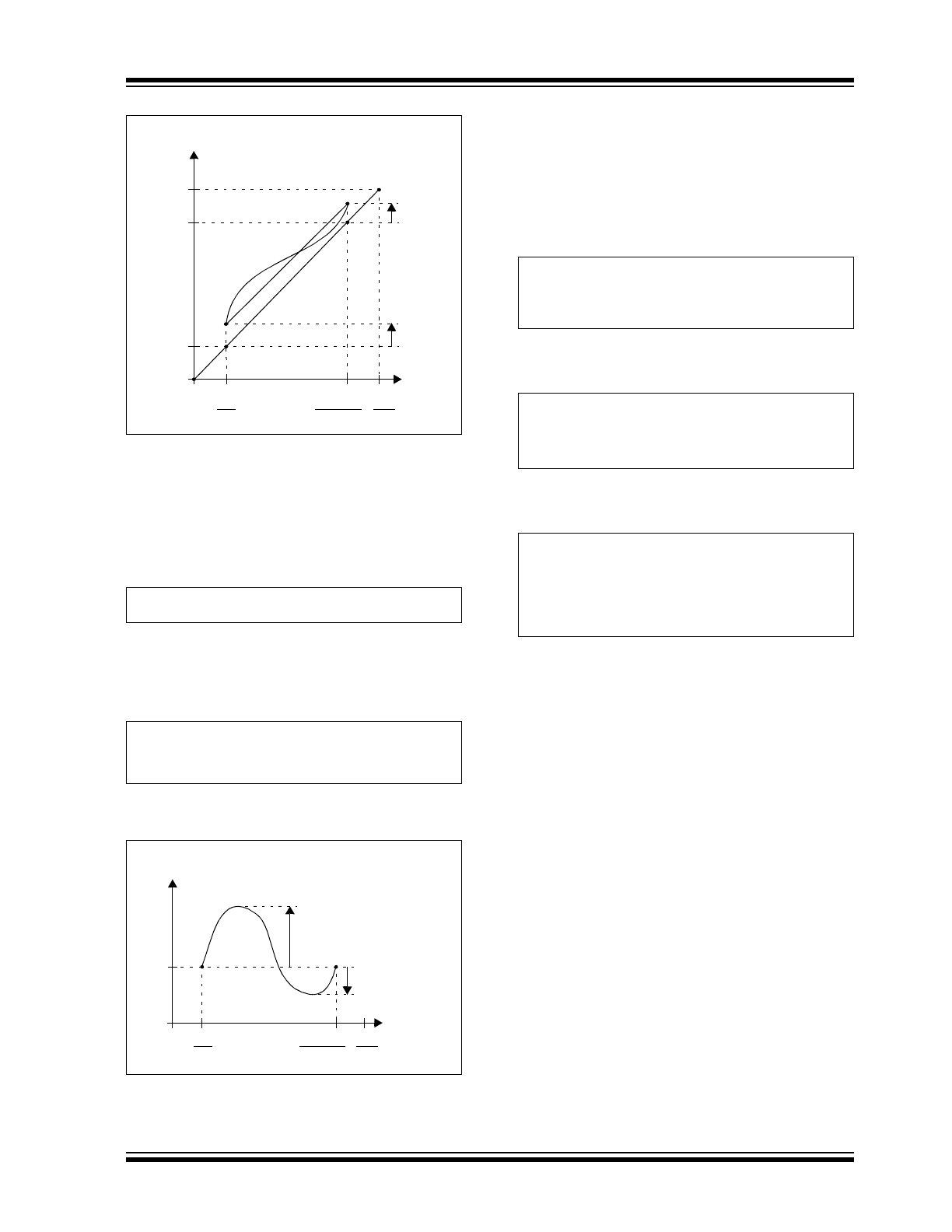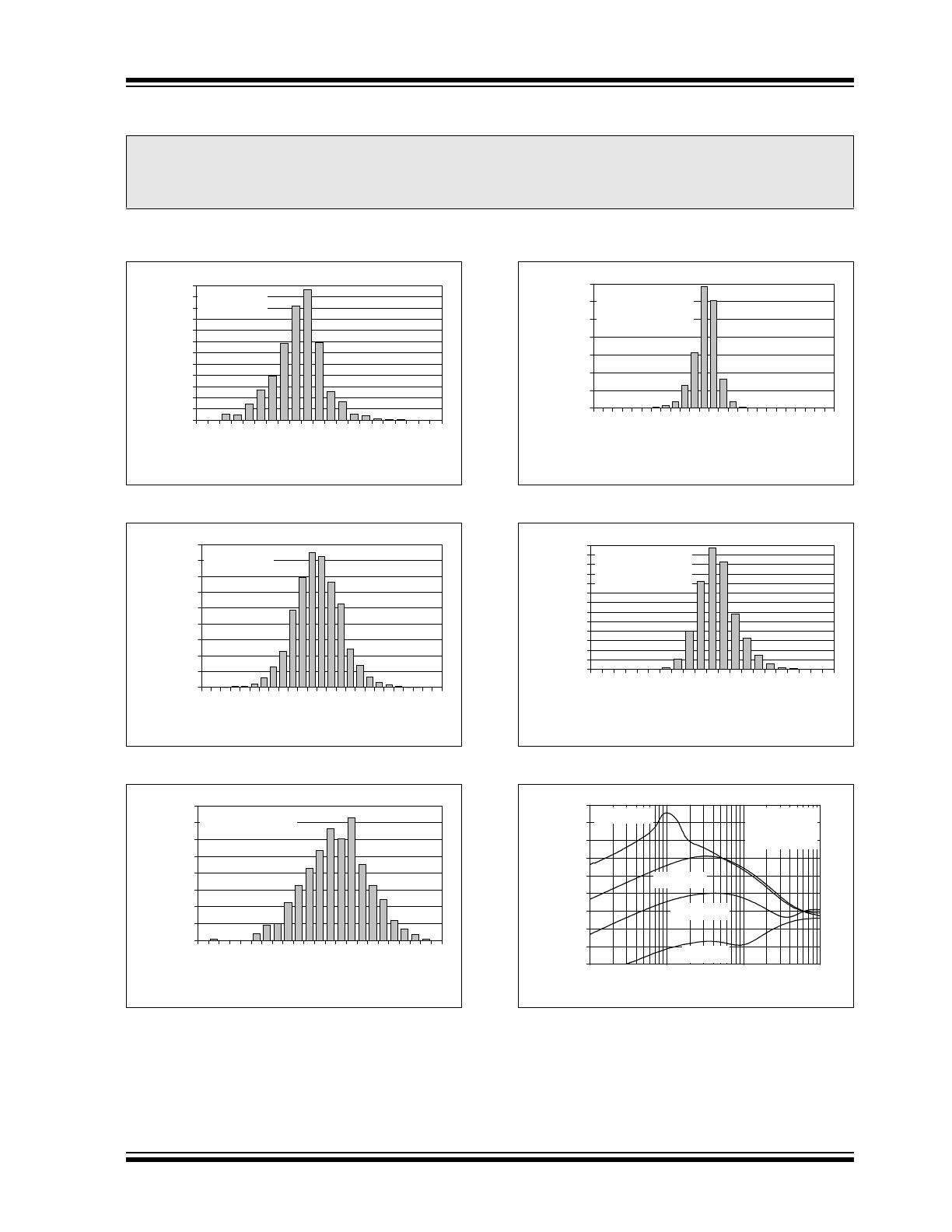
2004 Microchip Technology Inc.
DS21908A-page 1
MCP6S91/2/3
Features
• Multiplexed Inputs: 1 or 2 channels
• 8 Gain Selections:
- +1, +2, +4, +5, +8, +10, +16 or +32 V/V
• Serial Peripheral Interface (SPI
™
)
• Rail-to-Rail Input and Output
• Low Gain Error: ±1% (max.)
• Offset Mismatch Between Channels: 0 µV
• High Bandwidth: 1 to 18 MHz (typ.)
• Low Noise: 10 nV/
√
Hz @ 10 kHz (typ.)
• Low Supply Current: 1.0 mA (typ.)
• Single Supply: 2.5V to 5.5V
• Extended Temperature Range: -40°C to +125°C
Typical Applications
• A/D Converter Driver
• Multiplexed Analog Applications
• Data Acquisition
• Industrial Instrumentation
• Test Equipment
• Medical Instrumentation
Block Diagram
Description
The Microchip Technology Inc. MCP6S91/2/3 are
analog Programmable Gain Amplifiers (PGAs). They
can be configured for gains from +1 V/V to +32 V/V and
the input multiplexer can select one of up to two chan-
nels through a SPI port. The serial interface can also
put the PGA into shutdown to conserve power. These
PGAs are optimized for high-speed, low offset voltage
and single-supply operation with rail-to-rail input and
output capability. These specifications support single-
supply applications needing flexible performance or
multiple inputs.
The one-channel MCP6S91 and the two-channel
MCP6S92 are available in 8-pin PDIP, SOIC and MSOP
packages. The two-channel MCP6S93 is available in a
10-pin MSOP package. All parts are fully specified from
-40°C to +125°C.
Package Types
V
OUT
V
REF
V
DD
CS
SI
SO
SCK
CH1
CH0
V
SS
8
R
F
R
G
MUX
SPI™
Logic
Gain
Switches
R
e
si
sto
r La
dde
r (R
LA
D
)
V
REF
CH0
V
SS
SI
SCK
1
2
3
4
8
7
6
5
V
DD
CS
V
OUT
MCP6S91
PDIP, SOIC, MSOP
CH1
CH0
V
SS
SI
SCK
1
2
3
4
8
7
6
5
V
DD
CS
V
OUT
MCP6S92
PDIP, SOIC, MSOP
CH0
V
OUT
CH1
CS
1
2
3
4
10
9
8
7 SI
SCK
5
6
V
REF
V
DD
SO
V
SS
MCP6S93
MSOP
Single-Ended, Rail-to-Rail I/O, Low-Gain PGA

2004 Microchip Technology Inc.
DS21908A-page 2
MCP6S91/2/3
1.0
ELECTRICAL
CHARACTERISTICS
Absolute Maximum Ratings †
V
DD
– V
SS
........................................................................7.0V
All inputs and outputs..................... V
SS
– 0.3V to V
DD
+ 0.3V
Difference Input voltage ....................................... |V
DD
– V
SS
|
Output Short Circuit Current ..................................continuous
Current at Input Pin
.............................................................±
2 mA
Current at Output and Supply Pins
................................ ±
30 mA
Storage temperature .....................................-65°C to +150°C
Junction temperature .................................................. +150°C
ESD protection on all pins (HBM; MM)
................ ≥
4 kV; 200V
† Notice: Stresses above those listed under “Maximum
Ratings” may cause permanent damage to the device. This is
a stress rating only and functional operation of the device at
those or any other conditions above those indicated in the
operational listings of this specification is not implied.
Exposure to maximum rating conditions for extended periods
may affect device reliability.
PIN FUNCTION TABLE
Name
Function
V
OUT
Analog Output
CH0, CH1 Analog Inputs
V
REF
External Reference Pin
V
SS
Negative Power Supply
CS
SPI Chip Select
SI
SPI Serial Data Input
SO
SPI Serial Data Output
SCK
SPI Clock Input
V
DD
Positive Power Supply
DC CHARACTERISTICS
Electrical Specifications: Unless otherwise indicated, T
A
= +25°C, V
DD
= +2.5V to +5.5V, V
SS
= GND, V
REF
= V
SS
, G = +1 V/V,
Input = CH0 = (0.3V)/G, CH1 = 0.3V, R
L
= 10 k
Ω
to V
DD
/2, SI and SCK are tied low and CS is tied high.
Parameters
Sym
Min
Typ
Max
Units
Conditions
Amplifier Inputs (CH0, CH1)
Input Offset Voltage
V
OS
-4
—
+4
mV
G = +1
Input Offset Voltage Mismatch
∆
V
OS
—
0
—
µV
Between inputs (CH0, CH1)
Input Offset Voltage Drift
∆
V
OS
/
∆
T
A
—
±1.8
—
µV/°C
T
A
= -40°C to +125°C
Power Supply Rejection Ratio
PSRR
70
90
—
dB
G = +1 (Note 1)
Input Bias Current
I
B
—
±1
—
pA
CHx = V
DD
/2
Input Bias Current at
Temperature
I
B
—
30
—
pA
CHx = V
DD
/2, T
A
= +85°C
I
B
—
600
—
pA
CHx = V
DD
/2, T
A
= +125°C
Input Impedance
Z
IN
—
10
13
||7
—
Ω
||pF
Input Voltage Range
V
IVR
V
SS
−
0.3
—
V
DD
+ 0.3
V
(Note 2)
Reference Input (V
REF
)
Input Impedance
Z
IN_REF
—
(5/G)||6
—
k
Ω
||pF
Voltage Range
V
IVR_REF
V
SS
—
V
DD
V
(Note 2)
Amplifier Gain
Nominal Gains
G
—
1 to 32
—
V/V
+1, +2, +4, +5, +8, +10, +16 or +32
DC Gain Error
G = +1
g
E
-0.2
—
+0.2
%
V
OUT
≈
0.3V to V
DD
−
0.3V
G
≥
+2
g
E
-1.0
—
+1.0
%
V
OUT
≈
0.3V to V
DD
−
0.3V
DC Gain Drift
G = +1
∆
G/
∆
T
A
—
±0.0002
—
%/°C
T
A
= -40°C to +125°C
G
≥
+2
∆
G/
∆
T
A
—
±0.0004
—
%/°C
T
A
= -40°C to +125°C
Note
1:
R
LAD
(R
F
+R
G
in Figure 4-1) connects V
REF
, V
OUT
and the inverting input of the internal amplifier. The MCP6S92 has
V
REF
tied internally to V
SS
, so V
SS
is coupled to the internal amplifier and the PSRR spec describes PSRR+ only. It is
recommended that the MCP6S92’s V
SS
pin be tied directly to ground to avoid noise problems.
2:
The MCP6S92’s V
IVR
and V
IVR_REF
are not tested in production; they are set by design and characterization.
3:
I
Q
includes current in R
LAD
(typically 60 µA at V
OUT
= 0.3V). Both I
Q
and I
Q_SHDN
exclude digital switching currents.

2004 Microchip Technology Inc.
DS21908A-page 3
MCP6S91/2/3
Ladder Resistance
Ladder Resistance
R
LAD
3.4
4.9
6.4
k
Ω
(Note 1)
Ladder Resistance across
Temperature
∆
R
LAD
/
∆
T
A
—
+0.028
—
%/°C
T
A
= -40°C to +125°C (Note 1)
Amplifier Output
DC Output Non-linearity G = +1
V
ONL
—
±0.18
—
% of FSR V
OUT
≈
0.3V to V
DD
−
0.3V, V
DD
= 5.0V
G
≥
+2
V
ONL
—
±0.050
—
% of FSR V
OUT
≈
0.3V to V
DD
−
0.3V, V
DD
= 5.0V
Maximum Output Voltage Swing
V
OH_ANA
,
V
OL_ANA
V
SS
+ 20
—
V
DD
– 100
mV
G
≥
+2; 0.5V output overdrive
V
SS
+ 60
—
V
DD
– 60
G
≥
+2; 0.5V output overdrive,
V
REF
= V
DD
/2
Short Circuit Current
I
SC
—
±25
—
mA
Power Supply
Supply Voltage
V
DD
2.5
—
5.5
V
Minimum Valid Supply Voltage
V
DD_VAL
—
0.4
2.0
V
Register data still valid
Quiescent Current
I
Q
0.4
1.0
1.6
mA
I
O
= 0 (Note 3)
Quiescent Current, Shutdown
Mode
I
Q_SHDN
—
30
—
pA
I
O
= 0 (Note 3)
DC CHARACTERISTICS (CONTINUED)
Electrical Specifications: Unless otherwise indicated, T
A
= +25°C, V
DD
= +2.5V to +5.5V, V
SS
= GND, V
REF
= V
SS
, G = +1 V/V,
Input = CH0 = (0.3V)/G, CH1 = 0.3V, R
L
= 10 k
Ω
to V
DD
/2, SI and SCK are tied low and CS is tied high.
Parameters
Sym
Min
Typ
Max
Units
Conditions
Note
1:
R
LAD
(R
F
+R
G
in Figure 4-1) connects V
REF
, V
OUT
and the inverting input of the internal amplifier. The MCP6S92 has
V
REF
tied internally to V
SS
, so V
SS
is coupled to the internal amplifier and the PSRR spec describes PSRR+ only. It is
recommended that the MCP6S92’s V
SS
pin be tied directly to ground to avoid noise problems.
2:
The MCP6S92’s V
IVR
and V
IVR_REF
are not tested in production; they are set by design and characterization.
3:
I
Q
includes current in R
LAD
(typically 60 µA at V
OUT
= 0.3V). Both I
Q
and I
Q_SHDN
exclude digital switching currents.

2004 Microchip Technology Inc.
DS21908A-page 4
MCP6S91/2/3
AC CHARACTERISTICS
Electrical Specifications: Unless otherwise indicated, T
A
= +25°C, V
DD
= +2.5V to +5.5V, V
SS
= GND, V
REF
= V
SS
, G = +1 V/V,
Input = CH0 = (0.3V)/G, CH1 = 0.3V, R
L
= 10 k
Ω
to V
DD
/2, C
L
= 60 pF, SI and SCK are tied low and CS is tied high.
Parameters
Sym
Min
Typ
Max
Units
Conditions
Frequency Response
-3 dB Bandwidth
BW
—
1 to 18
—
MHz
All gains; V
OUT
< 100 mV
P-P
(Note 1)
Gain Peaking
GPK
—
0
—
dB
All gains; V
OUT
< 100 mV
P-P
Total Harmonic Distortion plus Noise
f = 20 kHz, G = +1 V/V
THD+N
—
0.0011
—
%
V
OUT
= 1.5V ± 1.0 V
PK
, V
DD
= 5.0V,
BW = 80 kHz, R
L
= 10 k
Ω
to 1.5V
f = 20 kHz, G = +1 V/V
THD+N
—
0.0089
—
%
V
OUT
= 2.5V ± 1.0 V
PK
, V
DD
= 5.0V,
BW = 80 kHz
f = 20 kHz, G = +4 V/V
THD+N
—
0.0045
—
%
V
OUT
= 2.5V ± 1.0 V
PK
, V
DD
= 5.0V,
BW = 80 kHz
f = 20 kHz, G = +16 V/V
THD+N
—
0.028
—
%
V
OUT
= 2.5V ± 1.0 V
PK
, V
DD
= 5.0V,
BW = 80 kHz
Step Response
Slew Rate
SR
—
4.0
—
V/µs
G = 1, 2
—
11
—
V/µs
G = 4, 5, 8, 10
—
22
—
V/µs
G = 16, 32
Noise
Input Noise Voltage
E
ni
—
4.5
—
µV
P-P
f = 0.1 Hz to 10 Hz (Note 2)
—
30
—
f = 0.1 Hz to 200 kHz (Note 2)
Input Noise Voltage Density
e
ni
—
10
—
nV/
√
Hz f = 10 kHz (Note 2)
Input Noise Current Density
i
ni
—
4
—
fA/
√
Hz
f = 10 kHz
Note
1:
See Table 4-1 for a list of typical numbers and Figure 2-25 for the frequency response versus gain.
2:
E
ni
and e
ni
include ladder resistance noise. See Figure 2-12 for e
ni
versus G data.

2004 Microchip Technology Inc.
DS21908A-page 5
MCP6S91/2/3
DIGITAL CHARACTERISTICS
Electrical Specifications: Unless otherwise indicated, T
A
= 25°C, V
DD
= +2.5V to +5.5V, V
SS
= GND, V
REF
= V
SS
, G = +1 V/V,
Input = CH0 = (0.3V)/G, CH1 = 0.3V, R
L
= 10 k
Ω
to V
DD
/2, C
L
= 60 pF, SI and SCK are tied low and CS is tied high.
Parameters
Sym
Min
Typ
Max
Units
Conditions
SPI Inputs (CS, SI, SCK)
Logic Threshold, Low
V
IL
0
—
0.3V
DD
V
Input Leakage Current
I
IL
-1.0
—
+1.0
µA
Logic Threshold, High
V
IH
0.7 V
DD
—
V
DD
V
Amplifier Output Leakage Current
—
-1.0
—
1.0
µA
In Shutdown mode
SPI Output (SO, for MCP6S93)
Logic Threshold, Low
V
OL_DIG
V
SS
—
V
SS
+0.4
V
I
OL
= 2.1 mA, V
DD
= 5V
Logic Threshold, High
V
OH_DIG
V
DD
– 0.5
—
V
DD
V
I
OH
= -400 µA
SPI Timing
Pin Capacitance
C
PIN
—
10
—
pF
All digital I/O pins
Input Rise/Fall Times (CS, SI, SCK)
t
RFI
—
—
2
µs
(Note 1)
Output Rise/Fall Times (SO)
t
RFO
—
5
—
ns
MCP6S93
CS High Time
t
CSH
40
—
—
ns
SCK Edge to CS Fall Setup Time
t
CS0
10
—
—
ns
SCK edge when CS is high
CS Fall to First SCK Edge Setup Time
t
CSSC
40
—
—
ns
SCK Frequency
f
SCK
—
—
10
MHz
V
DD
= 5V (Note 2)
SCK High Time
t
HI
40
—
—
ns
SCK Low Time
t
LO
40
—
—
ns
SCK Last Edge to CS Rise Setup Time
t
SCCS
30
—
—
ns
CS Rise to SCK Edge Setup Time
t
CS1
100
—
—
ns
SCK edge when CS is high
SI Setup Time
t
SU
40
—
—
ns
SI Hold Time
t
HD
10
—
—
ns
SCK to SO Valid Propagation Delay
t
DO
—
—
80
ns
MCP6S93
CS Rise to SO Forced to Zero
t
SOZ
—
—
80
ns
MCP6S93
Channel and Gain Select Timing
Channel Select Time
t
CH
—
1.5
—
µs
CHx = 0.6V, CHy = 0.3V, G = 1,
CHx to CHy select,
CS = 0.7 V
DD
to V
OUT
90% point
Gain Select Time
t
G
—
1
—
µs
CHx = CHy = 0.3V,
G = 5 to G = 1 select,
CS = 0.7 V
DD
to V
OUT
90% point
Shutdown Mode Timing
Out of Shutdown mode (CS goes high)
to Amplifier Output Turn-on Time
t
ON
—
3.5
10
µs
CS = 0.7 V
DD
to V
OUT
90% point
Into Shutdown mode (CS goes high) to
Amplifier Output High-Z Turn-off Time
t
OFF
—
1.5
—
µs
CS = 0.7 V
DD
to V
OUT
90% point
Note
1:
Not tested in production. Set by design and characterization.
2:
When using the device in the daisy-chain configuration, maximum clock frequency is determined by a combination of
propagation delay time (t
DO
≤
80 ns), data input set-up time (t
SU
≥
40 ns), SCK high time (t
HI
≥
40 ns) and SCK rise and
fall times of 5 ns. Maximum f
SCK
is therefore
≈
5.8 MHz.

2004 Microchip Technology Inc.
DS21908A-page 6
MCP6S91/2/3
TEMPERATURE CHARACTERISTICS
Electrical Specifications: Unless otherwise indicated, V
DD
= +2.5V to +5.5V, V
SS
= GND.
Parameters
Sym
Min
Typ
Max
Units
Conditions
Temperature Ranges
Specified Temperature Range
T
A
-40
—
+125
°C
(Note 1)
Operating Temperature Range
T
A
-40
—
+125
°C
Storage Temperature Range
T
A
-65
—
+150
°C
Thermal Package Resistances
Thermal Resistance, 8L-PDIP
θ
JA
—
85
—
°C/W
Thermal Resistance, 8L-SOIC
θ
JA
—
163
—
°C/W
Thermal Resistance, 8L-MSOP
θ
JA
—
206
—
°C/W
Thermal Resistance, 10L-MSOP
θ
JA
—
143
—
°C/W
Note 1:
Operation in this range must not cause T
J
to exceed Maximum Junction Temperature (+150°C).

2004 Microchip Technology Inc.
DS21908A-page 7
MCP6S91/2/3
FIGURE 1-1:
Channel Select Timing
Diagram.
FIGURE 1-2:
PGA Shutdown Timing
Diagram (must enter correct commands before
CS goes high).
FIGURE 1-3:
Gain Select Timing
Diagram.
FIGURE 1-4:
Detailed SPI™ Serial Interface Timing; SPI 0,0 Mode.
CS
V
OUT
t
CH
0.6V
0.3V
CS
t
OFF
V
OUT
t
ON
Hi-Z
Hi-Z
I
SS
30 pA (typ.)
1.0 mA (typ.)
0.3V
CS
V
OUT
t
G
1.5V
0.3V
CS
SCK
SI
t
SU
t
HD
t
CSSC
t
SCCS
t
CSH
SO
(first 16 bits out are always zeros)
t
DO
t
SOZ
t
LO
t
HI
1/f
SCK
t
CS0
t
CS1

2004 Microchip Technology Inc.
DS21908A-page 8
MCP6S91/2/3
FIGURE 1-5:
Detailed SPI™ Serial Interface Timing; SPI 1,1 Mode.
1.1
DC Output Voltage Specs / Model
1.1.1
IDEAL MODEL
The ideal PGA output voltage (V
OUT
) is:
EQUATION 1-1:
(see Figure 1-6). This equation holds when there are
no gain or offset errors and when the V
REF
pin is tied to
a low-impedance source (<< 0.1
Ω
) at ground potential
(V
SS
= 0V).
1.1.2
LINEAR MODEL
The PGA’s linear region of operation, including offset
and gain errors, is modeled by the line V
O_LIN
shown in
Figure 1-6.
EQUATION 1-2:
The end points of this line are at V
O_ID
= 0.3V and
V
DD
– 0.3V. Figure 1-6 shows the relationship between
the gain and offset specifications referred to in the
electrical specifications as follows:
EQUATION 1-3:
The DC Gain Drift (
∆
G/
∆
T
A
) can be calculated from the
change in g
E
across temperature. This is shown in the
following equation:
EQUATION 1-4:
CS
SCK
SI
t
SU
t
HD
t
CSSC
t
SCCS
SO
(first 16 bits out are always zeros)
t
DO
t
SOZ
t
HI
t
LO
1/f
SCK
t
CS1
t
CSH
t
CS0
Where:
G is the nominal gain
V
O_ID
G
VIN
=
V
REF
V
SS
0V
=
=
V
O_LIN
G 1
g
E
+
(
)
V
IN
0.3V
G
-----------
V
OS
+
–
0.3V
+
=
V
REF
V
SS
0V
=
=
g
E
100%
V
2
V
1
–
G V
DD
0.6V
–
(
)
--------------------------------------
=
V
OS
V
1
G 1
g
E
+
(
)
-------------------------
=
G
+1
=
G
∆
T
A
∆
⁄
g
E
∆
T
A
∆
----------
=

2004 Microchip Technology Inc.
DS21908A-page 9
MCP6S91/2/3
FIGURE 1-6:
Output Voltage Model with
the standard condition V
REF
= V
SS
= 0V.
1.1.3
OUTPUT NON-LINEARITY
Figure 1-7 shows the Integral Non-Linearity (INL) of the
output voltage.
EQUATION 1-5:
The output non-linearity specification in the Electrical
Specifications (with units of: % of FSR) is related to
Figure 1-7 by:
EQUATION 1-6:
The Full-Scale Range (FSR) is V
DD
– 0.6V
(0.3V to V
DD
– 0.3V).
FIGURE 1-7:
Output Voltage INL with the
standard condition V
REF
= V
SS
= 0 V.
1.1.4
DIFFERENT V
REF
CONDITIONS
Some of the plots in Section 2.0 “Typical Performance
Curves”, have the conditions V
REF
= V
DD
/2 or
V
REF
= V
DD
. The equations and figures above are easily
modified for these conditions. The ideal V
OUT
equation
becomes:
EQUATION 1-7:
The complete linear model is:
EQUATION 1-8:
where the new V
IN
end points are:
EQUATION 1-9:
The equations for extracting the specifications do not
change.
0
0
0.3
V
DD
– 0.3
V
DD
V
O
U
T
V
OUT
(V)
V
IN
(V)
0.3
V
DD
– 0.3 V
DD
G
G
G
V
1
V
O
_I
D
V
O
_L
IN
V
2
INL
V
OUT
V
O_LIN
–
=
V
ONL
max V
3
V
4
,
(
)
V
DD
0.6V
–
------------------------------- 100%
⋅
=
0
INL (V)
V
IN
(V)
0.3
V
DD
– 0.3 V
DD
G
G
G
0
V
3
V
4
V
O_ID
V
REF
G V
IN
V
REF
–
(
)
+
=
V
DD
V
REF
V
SS
0V
=
>
≥
V
ON_LIN
G 1
g
E
+
(
)
V
IN
V
IN_L
V
OS
+
–
(
)
0.3V
+
=
V
R EF
V
SS
0V
=
=
V
IN_L
0.3V
V
REF
–
G
------------------------------
V
REF
+
=
V
IN_H
V
DD
0.3V
–
V
REF
–
G
-----------------------------------------------
V
REF
+
=

2004 Microchip Technology Inc.
DS21908A-page 10
MCP6S91/2/3
2.0
TYPICAL PERFORMANCE CURVES
Note: Unless otherwise indicated, T
A
= +25°C, V
DD
= +2.5V to +5.5V, V
SS
= GND, V
REF
= V
SS
, G = +1 V/V,
Input = CH0 = (0.3V)/G, CH1 = 0.3V, R
L
= 10 k
Ω
to V
DD
/2 and C
L
= 60 pF.
FIGURE 2-1:
DC Gain Error, G = +1.
FIGURE 2-2:
DC Gain Error, G
≥
+2.
FIGURE 2-3:
Ladder Resistance Drift.
FIGURE 2-4:
DC Gain Drift, G = +1.
FIGURE 2-5:
DC Gain Drift, G
≥
+2.
FIGURE 2-6:
Crosstalk vs. Frequency
(circuit in Figure 6-4).
Note:
The graphs and tables provided following this note are a statistical summary based on a limited number of
samples and are provided for informational purposes only. The performance characteristics listed herein
are not tested or guaranteed. In some graphs or tables, the data presented may be outside the specified
operating range (e.g., outside specified power supply range) and therefore outside the warranted range.
0%
2%
4%
6%
8%
10%
12%
14%
16%
18%
20%
22%
24%
-0
.1
0
-0
.0
8
-0
.0
6
-0
.0
4
-0
.0
2
0.0
0
0.0
2
0.0
4
0.0
6
0.0
8
0.1
0
DC Gain Error (%)
P
e
rcen
tag
e
o
f O
ccur
re
nces
600 Samples
G = +1
0%
2%
4%
6%
8%
10%
12%
14%
16%
18%
-0
.6
-0
.5
-0
.4
-0
.3
-0
.2
-0
.1
0.0
0.1
0.2
0.3
0.4
0.5
0.6
DC Gain Error (%)
P
e
rcen
tag
e
o
f O
ccur
re
nce
s
600 Samples
G
≥
+2
0%
2%
4%
6%
8%
10%
12%
14%
16%
0
.019
0
.020
0
.021
0
.022
0
.023
0
.024
0
.025
0
.026
0
.027
0
.028
0
.029
0
.030
Ladder Resistance Drift (%/°C)
P
e
rc
ent
a
ge of Occu
rr
enc
e
s
597 Samples
T
A
= -40 to +125°C
0%
5%
10%
15%
20%
25%
30%
35%
-0.
0006
-0.
0005
-0.
0004
-0.
0003
-0.
0002
-0.
0001
0.
0000
0.
0001
0.
0002
0.
0003
0.
0004
0.
0005
0.
0006
DC Gain Drift (%/°C)
Pe
rce
n
ta
ge o
f O
ccur
re
nce
s
600 Samples
G = +1
T
A
= -40 to +125°C
0%
2%
4%
6%
8%
10%
12%
14%
16%
18%
20%
22%
24%
26%
-0.
0020
-0.
0016
-0.
0012
-0.
0008
-0.
0004
0.
0000
0.
0004
0.
0008
0.
0012
0.
0016
0.
0020
DC Gain Drift (%/°C)
Pe
rce
n
ta
ge o
f O
ccur
re
nce
s
600 Samples
G
≥
+2
T
A
= -40 to +125°C
-100
-90
-80
-70
-60
-50
-40
-30
-20
-10
1.E+05
1.E+06
1.E+07
1.E+08
Frequency (Hz)
C
ross
tal
k, In
pu
t R
e
fe
rr
ed
(d
B
)
V
DD
= 5.0V
G = +32 V/V
CH0 selected
R
S
= 1 k
Ω
R
S
= 0
Ω
R
S
= 100
Ω
R
S
= 10 k
Ω
100k
100M
10M
1M
